10
TRANSPORTATION INFRASTRUCTURE
Air Transportation Infrastructure
Air Navigation System
Since November 1, 1996, Canada's Air Navigation System (ANS)
has been managed by NAV Canada, a private, non-share capital corporation.
The Air Navigation System is made up of seven area control centres
(ACC), one stand-alone terminal control unit, 43 control
towers, 78 flight service stations and 67 maintenance centres,
plus more than 1,400 ground-based navigational aids. The system
provides services that include air traffic control, flight information,
weather briefings, airport advisories and electronic aids to navigation.
During 1999, NAV Canada used a due diligence approach to risk-manage
the Y2K issue from a safety perspective. It completed the identification,
assessment and upgrade of systems that were identified as
potential Y2K problems, and jointly tested systems with the Department
of National Defence, various airport authorities, the US Federal
Aviation Authority and the UK Aviation Authority. The corporation
also put contingency plans in place and ensured that all changes
to its information technology environment were monitored and Y2K-assessed.
As a result of these efforts, all NAV Canada operational systems
successfully made the transition to the Year 2000.
Air Navigation Operations
In the fiscal year ending August 31, 1999, NAV Canada centralized
it operations by merging its Pacific, Western and Central offices
into one regional office in Edmonton, saving $12 million. As part
of the next stage in the consolidation of administrative functions,
the company has initiated plans to create an Eastern Regional
Office that will consolidate the Ontario, Quebec and Atlantic
regional offices.
The air navigation system supported some 3.6 million aircraft
arrivals and departures at Canadian airports in the first six
months of 1999. This was 0.3 per cent more than in the same period
of 1998.
The distribution of aircraft arrivals and departures by type
of airport category is shown in Figure 10-10. The partial year
figures for 1999 reflect the slightly higher proportion of traffic
at towered airports during the winter months.
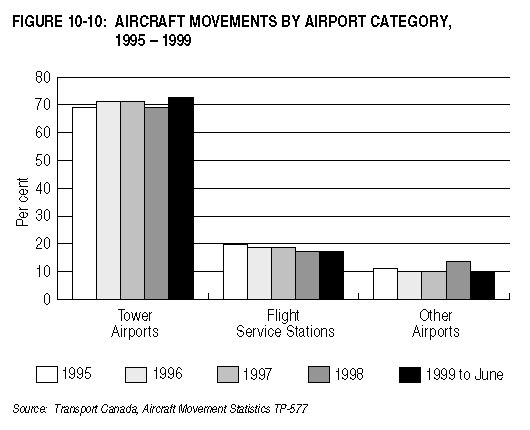
At the end of December 1999, the company had 156
air traffic controller trainees not yet licensed. The complement
of air traffic controllers, control towers and area control
centres for 1995 to 1999 are listed in Table 10-27.
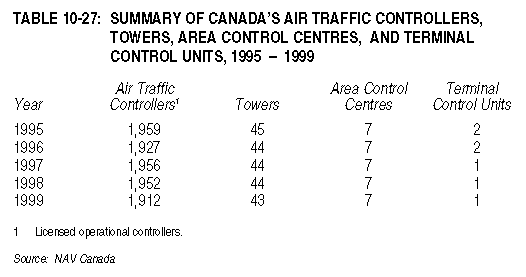
The total number of towers dropped by one in 1999 with the
closure of North Bay's tower in March. The number of area control
centres has remained constant since 1995. A NAV Canada study on
airspace sectorization was based on the clear statement that no
centres were to close.
System Improvements
Estimates for 1999/2000 show investment by NAV Canada
in technology to be about $100 million to $125 million. Along
with Y2K projects, the corporation's other major project in 1999
was the installation of back-up power systems in all area control
centres.
NAV Canada began hubbing its maintenance operations in 1999,
allowing a reduction in the number of maintenance centres while
continuing to meet its published maintenance response time policy.
Such a change was made possible by the increased reliability of
technology and the redundancies built into the system. Completion
of the implementation is targetted for August 2000, by which time
there will be a total of 46 centres.
In October 1999, NAV Canada announced $40 million in new capital
projects designed to enhance the safety of the ANS and improve
customer service. As some of these projects are multi-year, only
a portion of this investment is included in the 1999/2000 fiscal-year
total. These projects include:
- new radar systems in Yellowknife and Kuujjuaq
- a new digital voice communications system for towers and
flight service stations across the country
- new and updated radar processing hardware and software
- a new control tower for Kelowna.
Financial Performance
NAV Canada fully implemented user fees on November 1, 1998,
when the Air Transportation Tax was abolished completely, along
with transition-period payments. Increases to user fees scheduled
for that time were deferred to March 1, 1999, saving commercial
airlines around $72 million according to NAV Canada estimates.
With the abolition of transition payments by the government
to NAV Canada, the corporation became totally dependent financially
on its customers to generate sufficient revenues to cover all
its costs. The corporation's user-fee structure is in accordance
with the Civil Air Navigation Services Commercialization Act,
which restricts the corporation's revenues to an amount that includes
"reasonable prudent reserves" above the costs of operation.
NAV Canada collects its revenues in the form of charges levied
on aircraft operators for the provision or availability of air
navigation services. The charging system consists of terminal
and enroute charges, overflight charges and oceanic charges. Aircraft
weighing three metric tonnes or less pay a flat annual fee, while
aircraft weighing greater than three metric tonnes are charged
on a per movement or daily basis.
On September 1, 1999, NAV Canada introduced service charge
reductions that are expected to save users $100 million in the
ensuing 12 months. These changes resulted in a reduction of fees
for major services that vary from 7.5 per cent to 13.7 per cent,
depending on the service.
At applicable airports north of 60° N, Terminal Service
Charges are being introduced in two phases, the first of which
began November 1, 1999.
Figure 10-11 shows the fee sources for NAV Canada in percentage
terms for 1999.
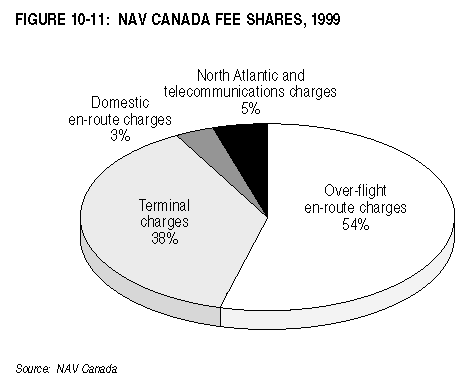
For the fiscal year ending August 31, 1999, NAV Canada reported
$933 million in revenues, $711 million in operating expenses,
and $215 million in interest, depreciation and restructuring expenses.
This resulted in an excess of revenues over expenses of $7
million. This compares with 1998 fiscal results of $892 million
in total revenues, $715 million in operating expenses, and
$172 million in interest, depreciation and restructuring
expenses for a $6 million excess of revenues over expenses. Table
10-28 compares NAV Canada financial results for 1998 and 1999.
Airports
Canada has approximately 1,800 aerodromes, the generic name
for facilities registered with Transport Canada as aircraft landing
and take-off sites. They are divided into three categories: water
bases for float and ski planes, heliports for helicopters,
and land airports for fixed-wing aircraft.
The more developed and active of these sites must meet Transport
Canada airport certification standards. By the end of 1999,
there were approximately 750 certified sites in all three categories,
representing a 19 per cent increase over the 631 reported in 1998.
This increase is due to clarifications in the requirements
for certification "within a built-up area," which resulted
in the addition of several helicopter landing sites (at hospitals,
for example) that had not previously been certified.
The number of certified land airports -- at which the majority
of commercial aviation activity takes place -- has remained relatively
stable since 1998. Of the total certified sites, 354 were certified
as land airports for fixed-wing aircraft in 1999.
Table 10-29 shows that of the total of 1,110 sites in the land
airport category, 238 offered scheduled passenger services in
1999, while the remaining 872 were available for other public
and private uses.

Over 94 per cent of all commercial passenger air traffic in
Canada is handled by 30 airports.Note 8
Prior to 1994, Transport Canada owned, operated or subsidized
149 airports. Since the introduction of the 1994 National Airports
Policy (NAP), however, most of these have been transferred to
locally based operators, either by way of lease -- as is
the case with the major airports within the National Airports
System (NAS) -- or sale.Note 9
In 1999, airports in Saskatoon, Regina, Charlottetown and Saint
John were transferred to not-for-profit airport authorities. Halifax
was transferred at the beginning of the year 2000, leaving only
four NAS airports under Transport Canada management. Figures 10-12,
10-13 and 10-14 show the location of each airport and
its divestiture status as of December 31, 1999.

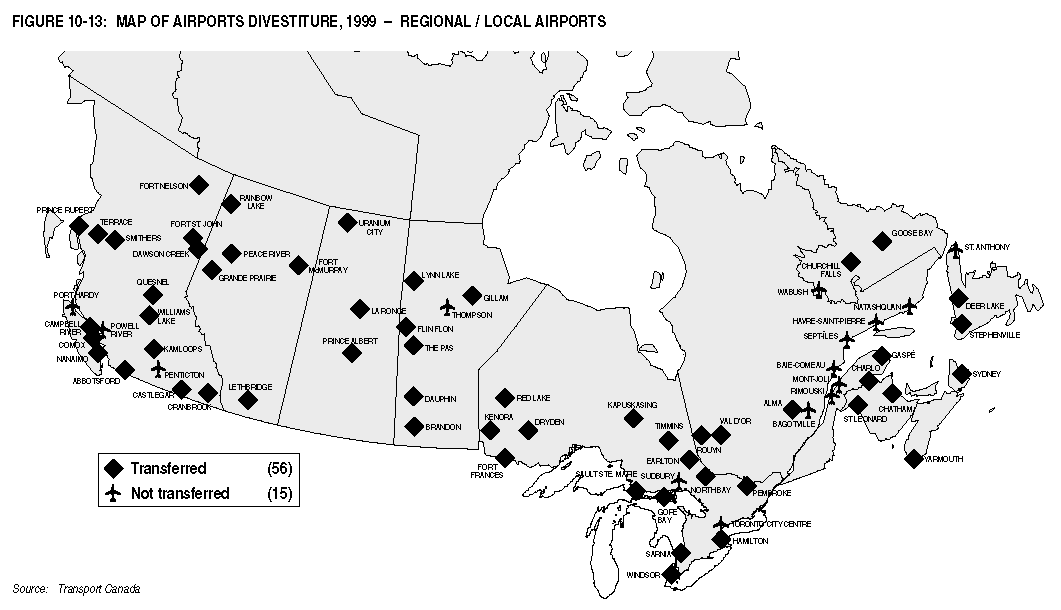

Over the past year, airport authorities continued to pursue
improvements to airport infrastructure, operations and customer
service. Victoria, Saskatoon, Ottawa and St. John's announced
expansion and renovation plans, while Vancouver, Calgary, Edmonton,
Montreal, Toronto and Moncton continued to implement capital improvement
programs they had started in previous years. Airline restructuring
initiatives introduced toward the end of 1999 may affect the timing
of expansion at some airports. All airports are examining the
potential impact to their particular environments.
By the end of 1999, most airport authorities had introduced
airport improvement fees (AIFs) as a means of funding capital
projects. In addition, most had entered into agreements whereby
the airlines collect airport improvement fees from passengers
at the time of ticket purchase. The amount of the airport improvement
fee is shown separately on the ticket.
Table 10-30 lists the airports that charge airport improvement
fees, as well as when they started and the amount collected in
1998.

Review of Airport Authority Leases
Between 1997 and 1999, Transport Canada conducted a review
of the Vancouver, Calgary, Edmonton and Montreal airport authorities.
Established in 1992, they were the first four locally based airport
authorities to operate airports. The LAA Lease Review Consultation
Report, which was made available to stakeholders in April 1999,
found the airport transfer policy to be a success. Canada has
seen a rapid expansion at several National Airport System airports,
at no cost to the taxpayer, and the provision of better service
to the travelling public. The review confirmed that the government's
decision to commercialize its key airports was a sound one, and
that the 1994 National Airports Policy was a positive step.
The report also concluded that notwithstanding the many successes,
some refinements should be considered to ensure the continued
effectiveness of the policy. In particular, the review noted deficiencies
in transparency relating to pricing practices and financial reporting
by some local airport authorities. In keeping with these conclusions,
it is expected that several "best practices" in place
at some of the airports will be made standard across the National
Airport System when the review is completed.
Financial Performance
Airport Authorities' Revenues and Expenses
National Airports System airports are expected to eventually
reach financial self-sufficiency. Airport authorities, incorporated
as not-for-profit organizations with no equity shareholders, fund
their operations and improvements with revenues derived from airport
users. Under leases, the federal government (the owner of the
airports) collects rent from the airport authorities.
In 1999, ten airport authorities issued annual reports for
the full calendar year 1998. These financial results are summarized
in Table 10-31. With 67.2 million enplaned/ deplaned passengers,
these airport authorities generated on average $14.45 per passenger
in revenues and incurred expenses of $10.84 per passenger in 1998.
In addition, the airports combined spent a total of $436.3
million on the acquisition of capital assets. All ten airport
authorities, with the exception of Moncton, showed a net profit
in 1998. Moncton generated revenues from airport improvement fees
for only a portion of the year.
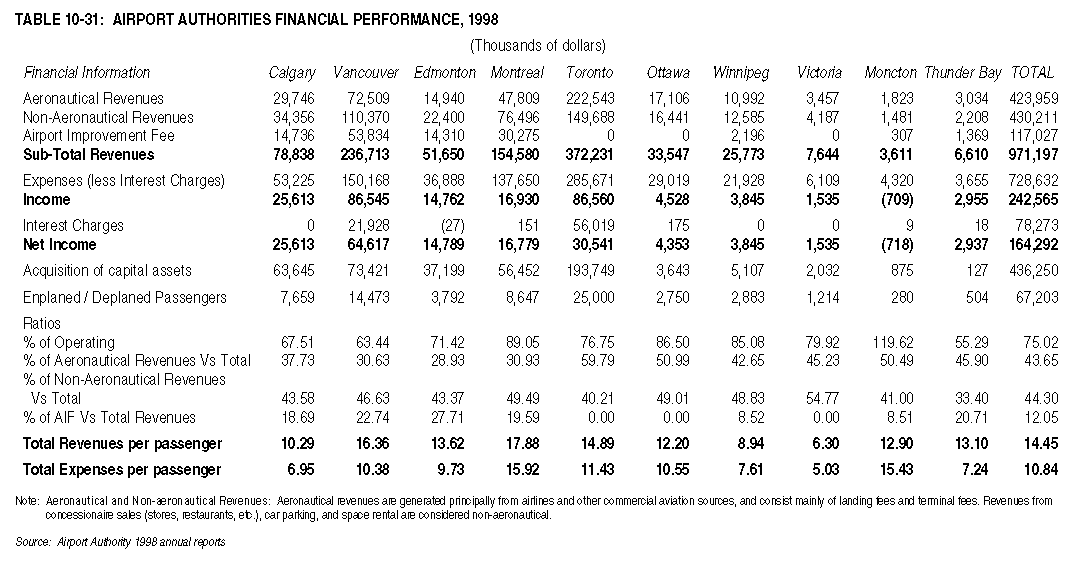
In 1998, the ten airport authorities generated total revenues
of $971.2 million, with total expenses (before interest) of $728.6
million. Revenues of $424.0 million from aeronautical sources
represented 43.7 per cent of their total revenues as a group.
Individually, the percentage of total revenues generated from
aeronautical sources ranged from 28.9 to 59.8 per cent.
In 1998, non-aeronautical revenues (excluding airport improvement
fees) totalled $430.2 million, or 44.3 per cent of all revenues
generated by these ten airport authorities. On a site-by-site
basis, the percentages ranged from 33.4 per cent at Thunder Bay,
to 54.5 per cent at Victoria. Airport improvement fees generated
$117.0 million, or 12.1 per cent of total revenues.
Transport Canada's Revenues and Expenses
With the transfer of airports to locally based airport authorities,
Transport Canada's expenditures and revenues from the operation
of airports are declining, while lease revenues are increasing.
In 1998/99, Transport Canada spent $179.8 million on the operation
of airports and took in revenues of $78.2 million. It received
an additional $190.2 million in rent from the airport authorities.
For fiscal year 1999/2000, Transport Canada forecasts $165.6 million
in spending, $53.8 million in revenues and $211.2 million
in rent.
Airport Capital Assistance Program
The Airport Capital Assistance Program (ACAP) was established
in April 1995 to help eligible non-National Airport System airports
finance capital projects related to safety, asset protection
and operating-cost reduction. To be eligible for this
funding, the airports must receive a minimum of 1,000 regularly
scheduled passengers annually, meet airport certification requirements
and not be owned by the federal government.
In 1999, 47 projects at 56 airports were approved for funding,
at a total estimated cost of $30.4 million. Approved projects
included the rehabilitation of runway, taxiway and apron pavements;
the purchase of mobile equipment, such as runway sweepers, snow
blowers and sander trucks; the refurbishment of air terminal buildings;
the purchase and installation of visual aids; and the installation
of security fencing.
After an evaluation of the Airport Capital Assistance Program,
Transport Canada concluded in 1999 that the rationale behind,
and the delivery of, the program is consistent with the department's
top priority -- safety -- and should therefore continue.
Table 10-32 summarizes Airport Capital Assistance Program expenditures
by province from 1995/96 to 1998/99.

Appendix 10-1
lists the projects receiving funding approval under the program,
by site and province in 1999.
Air Transportation Infrastructure
- Appendix 10-1 Personal Expenditures
on Transportation, 1998
NOTES
8
Top 30 airports in terms of enplaned plus deplaned passengers.
9
More detailed information on the National Airports Policy and
the status of airport divestitures is available on Transport Canada's
Web site at www.tc.gc.ca/en/airports.htm.
|

